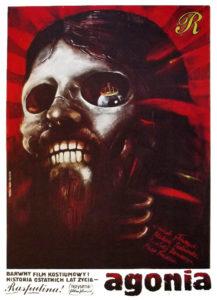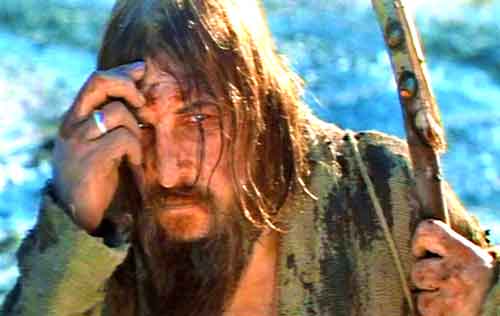 This once-banned Russian epic is a crazed exercise in historical revisionism centering on Grigori Rasputin, one of the Twentieth Century’s most fascinating personages. This film’s take on the man, as an out-and-out lunatic, is questionable to be sure, but it’s such an irresistibly delirious viewing experience that I was willing to go along with it.
This once-banned Russian epic is a crazed exercise in historical revisionism centering on Grigori Rasputin, one of the Twentieth Century’s most fascinating personages. This film’s take on the man, as an out-and-out lunatic, is questionable to be sure, but it’s such an irresistibly delirious viewing experience that I was willing to go along with it.
…an irresistibly delirious viewing experience…
Grigori Efimovich Rasputin, for those who don’t know, was a religious minded peasant with a penchant for orgies and telepathic “healing” who managed to exert his influence over the Russian Tsar and Tsarina—and thus the entire country—in the early part of the Twentieth Century. Depending on whom you ask Rasputin was either a sex-crazed maniac or a misunderstood holy man. In any event, his brutal murder in 1916 marked the end of the 300-year Romanov Dynasty and precipitated the rise of Communism.
The expansive Rasputin biopic AGONY (AGONIYA) was made in the seventies by the late, great Elem Klimov and is very much in keeping with the Communist view of Rasputin and the time in which he thrived, as articulated by the Lenin quote that opens the film: “The first revolution laid bare the true nature of the Czarist monarchy…and exposed the rottenness and corruption, the cynicism and debauchery among the Czar’s followers, with the monstrous Rasputin leading the pack.”
In spite of that, AGONY, initially completed in 1975, was banned by Communist authorities, who apparently found its depiction of the Czar too sympathetic. Klimov, possibly under pressure from the higher-ups, recut the film in 1985, from an initial length of 156 minutes down to 143, and years later the film was pared down yet again to a 110 minute bowdlerization that was released on video in the US (under the title RASPUTIN). The version under review here is the 1985 one, available on DVD from Ruscico. I haven’t seen the original 156 minute version, but did experience the 110 minute one, and so can say with certainty that you’re better off with the present cut, at least until the 1975 version becomes available (for which I’m not exactly holding my breath).
AGONY, initially completed in 1975, was banned by Communist authorities, who apparently found its depiction of the Czar too sympathetic.
The film begins in 1916, with the Russian monarchy in decline. The country is in the grip of a never-ending war and the psychotic Rasputin holds sway over the Tsarina because she believes he’s the only person who can cure her young son from the hemophilia that has afflicted him since birth. The Tsar wants to send Rasputin back to his home in Siberia, but the latter manages to hypnotize his master, and even inspires him to order some questionable military maneuvers.
Rasputin spends his days engaged in orgies, at least when he’s not creating nutty laws and taking people’s money. It seems that everywhere Rasputin goes he causes discord, from a party where he starts a ruckus by groping a noblewoman to his own peasant hometown, where he goes nuts after one of his relatives calls him a thief. As the Czar loses his grip on the populace and the country slips into anarchy, a plot is hatched to do Rasputin in and is carried out one faithful night: Rasputin is poisoned and shot several times, leading to the dissolution of the monarchy and, in the “happy” ending, the rise of communism.
Historically questionable as this film is, it’s brilliantly put together. Its view of Russian life in 1916 as an unending nightmare presided over by a raving madman is damned persuasive; Elem Klimov, as anyone who’s seen his brilliant ecological drama FAREWELL (1983) or his WWII masterpiece COME AND SEE (1985) well knows, had a flair for nightmarish imagery that remains unmatched. AGONY is far from a straightforward historical saga, featuring as it does a lead performance by Alexei Petrenko that’s so wildly unhinged it often approaches camp. In addition, Klimov crafts moments of amazing hallucinatory grandeur: in one bizarre scene a man lifts a portion of a seemingly solid wall to reveal a hidden corridor he disappears into; there’s also a delirious bit in which Rasputin rants to the Czarina, a truly stunning sequence conveyed via a series of rapid fire edits and discordant sounds.
 Mention must also be made of the innovative use of vintage newsreels, which are intercut seamlessly into Klimov’s widescreen color palette, creating a unique marriage of fiction and documentary. The sound mix is another important component, obtaining its effects through a number of imaginative means, most notably a low pitched drone that often plays under scenes, just loud enough to give the proceedings a foreboding ambiance that subtly unnerves. The one area where the film falls short is its jumbled, episodic narrative; storytelling was never Klimov’s strong point, and AGONY, like his other films, works far better as an expressionistic mood piece than the straightforward chronicle it was apparently intended as.
Mention must also be made of the innovative use of vintage newsreels, which are intercut seamlessly into Klimov’s widescreen color palette, creating a unique marriage of fiction and documentary. The sound mix is another important component, obtaining its effects through a number of imaginative means, most notably a low pitched drone that often plays under scenes, just loud enough to give the proceedings a foreboding ambiance that subtly unnerves. The one area where the film falls short is its jumbled, episodic narrative; storytelling was never Klimov’s strong point, and AGONY, like his other films, works far better as an expressionistic mood piece than the straightforward chronicle it was apparently intended as.
Underneath all of this remains the nagging question of historical authenticity. Anyone who’s read anything about the man and the time will have to wonder just how many of the oft-nutty events Klimov “recreates” actually occurred. Not too many, I’m guessing. Even Rasputin’s gruesome murder, which according to this film involved poisoning and half a dozen bullet wounds, is inaccurately depicted (believe it or not, his real life assassination was even more outrageous, featuring castration, bondage and drowning in addition to the above). Not having been around Russia in 1916, I guess I’ll have to give AGONY the benefit of the doubt…although I’d strongly advise prospective viewers to do some independent research.
Vital Statistics
AGONY (AGONIYA)
Mosfilm
Director: Elem Klimov
Screenplay: Semyon Lungin, Ilya Nusinov
Cinematography: Leonid Kalashnikov
Editing: Valeriya Belova
Cast: Alexei Petrenko, Anatoly Romashin, Velta Line, Alissa Freindlikh, Alexander Romantsev, Yuri Katin-Yartsev, Leonid Bronevoy, Pavel Pankov, Mikhail Danilov, Mikhail Svetin, Nelli Pshyonnaya, Boris Romanov

